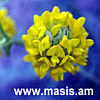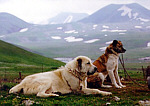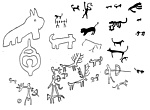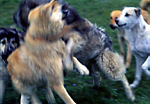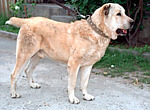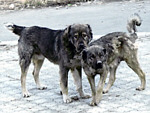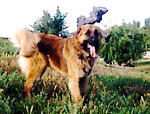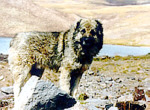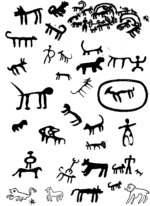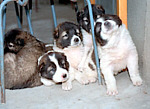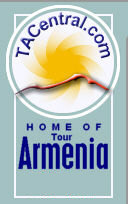 |
||||||||||||||||||||||||||||||||||
|
||||||||||||||||||||||||||||||||||
|
||||||||||||||||||||||||||||||||||
|
|||||||||||||||||||||||
 |
|||||||||||||||||||||||
| - | |||||||||||||||||||||||
|
||||
| Armenian Shepherds: the Gampr Deified as Aralez
[To see more images visit our Gampr image page] It's seems fairly obvious to dog lovers and canine experts living here that a distinct breed of shepherd dog would have originated in Armenia. After all, shepherds have been a part of the landscape for thousands of years. The breed native to Armenia has been registered as the Caucasian Ovcharka, which is a Russian term. Turkey has registered three breeds that originate in Armenia, the Kangal, Anatolian Shepherd and the Akhbash. Armenian canine clubs are scrambling to have the names registered with an Armenian nome de canine, suggestions being the Armenian Wolfhound (Gamp'r) and Aralez. Armenian shepherd dogs originated 15,000 years ago, when ancestors on the Armenian plateau (ioncluding anatolia) first began domesticated cattle, sheep and goats. Legend ascribes mystical powers to one breed, beginning with the story of Ara Geghetsik and Semiramis. Semiramis is reputed to have conjured the powers of a god in the shape of a dog, called Aralez, to revive the fallen hero. Some thought this meant the origin of that breed was Assyria, but older Mesopotamian chronicles record the incorporation of a new god based on the Holly Dog from Armenia. Aralez was a part of the old pantheon of Armenian gods, prescribed with the powers of reviving the dead. Very sturdy and friendly, Armenian Shepherds are found in all rural mountainous areas. The government of Armenia is in the intial stages of registering the standard of the Gampr or Aralez, whch is necessary to stave off erroneous claims by Turkey and Russia that this species, endemic to Armenia, is somehow theirs. In order for the standard to be recognized in internationnal breeding circles, this registraiton is vital. The following article has been prepared to bolster this process. Armenian Gampr Armenia is a home to tens of thousands of endemic species, most of which interest the scientific mind only. But a few draw keen interest because they contributed to the formation of numerous breeds worldwide, while maintaining a unique place in the history, mythology and culture of Armenia itself. Among these is the gampr, a breed of dog endemic to the Armenian highlands, and one that can trace its ancestry to prehistoric settlements and recordings on the faces of the mountains themselves. In fact, the gampr is so closely tied to the history and culture of Armenia, it is surprising so few know that this dog originated in historic Armenia, preferring to call it by its Turkish and Soviet usurped nomers. Origins The origins of the gampr sprung from the Armenian Plateau, one of the cradles of civilization. Archeological excavations in the Hrazdan Valley, near Bjini, uncovered human skeletal remains dating to 1-2 million BC. Wide ranging habitation by humans begin around 500,000 BC with the first discovered human settlements around 90,000 BC. Domesticated agriculture and livestock in Armenia dates back as early as 25,000 BC, roughly 10,000 years before discovered domestication in other areas of the Near East. At the same time, evidence of the domestication of dogs is shown on prehistoric carvings. Unlike the domestication of other animals as well - horses, cats, birds, cattle, even lynxes and other wild creatures, the dog was unique, having a special place in the home as well as in the field, accompanying its master in work, play and battle. Early Recordings and Development No one knows for sure the exact time when the gampr was domesticated, early sources are quite unclear on this account, often bickering among themselves to prove an academic point. While there is a huge diversity among the endemic species dating back tens of thousand of years, the prototype of the modern gampr was formed 3000 years ago. Petroglyphs found in the Armenian Plateau, beginning ca. 15,000-12,000 BC, show a large number and variety of dog types, providing a record of development. Of the hundreds of petroglyphs found at Ughtasar and on the Geghama mountain range, up to 20% of the carvings resemble the modern gampr, while others show a remarkable diversity of dog that no longer exists. A monograph by S. Dal, "Sevan plateau's transcaucasian shepherd dog, 1st millenium BC" described the results of an excavation conducted in 1954 by Lake Sevan. In the excavation site dating approx. 800 - 1000 BC, they found a well preserved dog skeleton in one of the tombs. By comparing the skull with the head of a modern gampr and other canines, Dal concluded that it was a then typical representative of the breed, although there are some marked differences from the modern type, like longer head-face, narrower head box and stronger teeth. Dal concluded that although the selection and breeding process of the last 3000 years affected the dogs general appearance and size, the gampr was already established and formed as a breed in the 1st millenium BC. As a result of these finds it is now believed that natural selection and breeding over the millennia 'built' the modern gampr, a breed that shows traits of the older dog types represented in the carvings while maintaining its own unique physiology. And despite the conjectures of outside nations that the dog originated outside of the Armenian Plateau, and was somehow introduced by countries as far flung as Tibet, there is an endemic species of dog on the Armenian Plateau that is recorded as early as 12,000 BC. The close link between ancient dogs and their owners manifested itself in the mythical Aralez (ca. 5000-2000 BC), the Armenian god of healing, depicted as a dog. The god resurrected men fallen in battle by licking their wounds. In a famous Armenian myth, the dog-god Aralez revived Ara the Handsome in this way. In the myth Ara prefers to die in battle rather then accept the advances of Shamiram (in Assyrian, Queen "Semiramis"), and Shamiram, desperate with grief over his death, and in one version faced with the wrath of the people for causing his death, begs Aralez to revive Ara. It is most likely that the myth originated and occurred in the modern Arzni region, the name Arzni a derivative of two Armenian word: Ara and zni, for ˇĄlickˇ¦. Arzni also lies between Arai lehr (literally "Araˇ¦s mountain") and Mt. Hadis, also known as Shamiram mountain. Beginning with the Ottoman invasion of Armenia in the 9th c. AD, and especially with its conquest in the 13-14th centuries, the gampr was highly prized by the invading Ottomans, with numerous historical references listing the gampr as war booty or tribute from Armenians to their Turkish masters. One historical source states that monks from St. Bernard monastery came to Armenia for rescue dogs. This is entirely possible, since Armenian Gampr Storm dogs were very popular at that time. According to 5th century historian Movses Khorenatsi, the 1st century Armenian king Sanatruk got his name after he was rescued by a Gampr Storm Dog from under the snows when he was few months old. Over time, the gampr lost its footing in Turkish favor, and beginning with the Armenian genocide in 1915, much of the breed disappeared in Turk inhabited areas, but persevered in the regions inhabited by Kurds, who were mostly engaged in sheep herding. By the modern era the dog had developed enough that broad descriptions could be distilled into a specific type, this type being highly prized. Take for example, excerpts from a book devoted to the Dersim region of historic Armenia: "In Mndzur highlands one pedigreed dog costs 640 kg corn, or a horse, or two cows, or 10 sheep, 80 kg honey, 80 kg butter, etc. If the poor man from Mndzur wanted to have a gampr but did not have anything to trade for, he has to work 80 days for free for the dog's owner. In Sasun it costs 10-12 sheep. Most powerful dogs cost up to 30-40 sheep. Killing the gampr was considered as a murder." And from a 1913 book, "Study on the pets of the Caucasus region," by Prof. Conrad Keller: ... I never saw German Shepherd Dogs in the Caucasus countries, this most likely results from the fact that the Caucasian shepherds have a far better breed to guard their livestock. ... The height at withers is 70-75cm [28-30"], some males of the Armenian highlands are even 80cm [32"] tall. ... Also the Kurds at the Ararat mountain warned my travel companions not to get close to their dogs. ... In reference of geographic dissemination, verbal descriptions about shepherd dogs of the Caucasus are definitely mountain dogs. They are very seldom met in the plains, at least not in a pedigreed existence. Between 1000 and 2300 meters (3000 -6900 ft) above sea level you see them with all Alp shepherds. ... At the coast of the Black Sea, Russian dog enthusiasts told me the largest number and most beautiful shepherd dogs can be found in the Armenian highlands. I was able to confirm this later. I saw extremely nice pedigreed dogs in the Ararat region and in Jelenovka at the Goktscha lake (sevan's old name), which is almost 2000 meters above sea level. Some individuals were the size of a strong St. Bernard or Leonberger. ... ... ... Gamprs continued to be exported after the Soviet revolution. "In 1934, Koshelev and Timashouk wrote in their book "Shepherd and Guard Dogs in Sovkhoses of the North Caucasus Region and Dog Breeding in Armenia", that "dog breeding is in a deplorable condition (in Armenia). There are practically no bitches and puppies left. Some villages, and even sovkhoses, do not have a single bitch to speak of. The majority of the dogs are of 5 - 7 years of age." "The dogs that are left are deficient in terms of exterior. Until recently, Armenia was the source of relentless and massive export of pedigree dogs, mostly at an institutional level. As a result, dog breeding in many regions of Armenia is crumpling..." Further confusion concerning the origin of the Armenian gampr was certainly promulgated during the Soviet period, Soviet military authorities established breeding centers in Leningrad, Moscow, Ukraine and Georgia, experimenting with cross breeds based on the gampr strain. They succeeded in creating new mixes but instead of naming the cross breeds separately, they renamed the entire breed. Pure strains and new mixes both were called the "kovkazskaya ovcharka" (Caucasian Ovcharka). In defense, the Soviets said that the dog had different names for different Caucasian nations, so they generalized it into a single name. Unfortunately this left out the gampr as the source breed and Armenia as the source land. This generalization was propelled by the confusions created in attempting to originate the breeds by nationalities. The father of soviet cynologia was a military canine expert named A. P. Mazover. It was his idea to divide both the pure and mixed breeds not by types, but by their ˇĄnationalityˇ¦, and so invented the terms Georgian, Azeri and Armenian types, stating throughout that the Georgian type is better. It should be noted his statements were made and then repeated throughout the 40's-50's, during the height of Stalin's reign. Stalin was a Georgian. Ironically, by mixing breeds, they proved the lie, the underlying genetics are unmistakably the Armenian gampr. In 1930 the Gampr was first exposed to the west via Germany, beginning with an all-German exhibition in Nuremberg. Three gamprs were exhibited, the press calling them "red giants", no doubt influenced in part by labels on their cages stating "Death to Capitalism". Long neglected by the Turks, it is only in the last 20 years or so that the gampr has begun to win new recognition in Turkish official circles, though with different names. Eliminating all references to Armenia, the Armenian Plateau or the endemic nature of the gampr, Turkey championed several ˇĄnewˇ¦ breeds based on the Armenian gampr and produced numerous emblems, stamps etc with Gampr picture surrounded by half-moons to reinforce the illusion that the dog was Turkish: Kangal - a large dog with powerful head, shorthaired; Anatolian Karabash - not so large, mainly the working shepherd type; Akbash ('white head') - newly renamed by the Turks, a typical valley dog, with lighter bone structure and a narrow head. Of this latter, Kurds in Turkey have expressed pride that the Akbash can live without being fed, the dogs dividing their time between shepherding duties and hunting for survival. Politics plays big in this area, even in the dog world. In recent years the Turks have even become apprehensive about the use of the word 'Anatolian', which illustrates the pre-ownership of the territory by other races, and Turkey's tenuous hold on historical rights. Of all things, the Turkish Minister of Agriculture sent a letter to international canine organizations/clubs, declaring that from that moment on there was no longer the breed Anatolian Karabash, but rather a "new" breed called the Kars dog. Kars, by the way, is one of the oldest Armenian cities of the region, a capital of Armenia in the 10th century AD, presently located in the territory of Turkey. Another letter of note, showing the political fight for ownership in action is from Prof. Dr. O. Cenap Tekinsen, Dean of the Faculty of Veterinary Medicine, Seljuk University. http://www.turkishdogs.com/accreditation.html The West in particular picked up on these names without confirming the endemic origins of the "new" breeds, began using the new name for all the breeds introduced by the Soviet Union or Turkey. In 1996, the FCI registered the standard of the Caucasian Ovcharka with "Country of the origin - Georgia". This without proof of origin, but taken from the Soviet naming. As are result more than 80% of native Armenian working dogs were eliminated from any records, suddenly becoming "invisible". See also http://www.rfss.ru/eng/caucasian_shepherd_dog/standart328.shtml http://www.arba.org/Breed%20Standards/CaucasianOvtcharka.htm http://www.arba.org/Breed%20Standards/akbash.htm http://www.arba.org/Breed%20Standards/Anatolian_Shepherd.htm This confusion and subterfuge are illustrated by a conversation between two German canine experts. The first said that the new 'Kars' dogs are the same type that is now widespread in the modern Armenia, and so the same animal. The other argued how could that be since Kars is in Turkey, the Armenians and Turks are not in good relations and the boundaries are strictly closed, so how could this dog pass the border to go from Kars to Armenia? The first said that he "heard that once Kars was part of Armenia" so maybe there is some relation. Geographic and Other Influences The Armenian plateau encompasses roughly half of present day Turkey, the mountainous regions of Syria, Iraq and Iran, Azerbaijan, the southwestern edge of Georgia and current Armenia. The plateau is divided into mountain chains and river gorges interspersed with lowland to upper highland steppes and alpine meadows, and encompasses a territory about the size of Texas or France. This compact area is remarkable for its diversity, possessing 8 of the worldˇ¦s 10 climactic and geographic zones, where 2/3rds of Europeˇ¦s bird species migrate and 30% of its flora species inhabit, where rare and endemic species like the Caucasian bearded goat, the Caucasian Leopard and the now extinct West Asian Tiger lived, where stifling heat suddenly gives way to an arctic frost, where the environment, flora and fauna transform with each change of altitude. These harsh and changeable conditions, over thousands of years of natural selection and isolation shaped a unique dog breed we call the "gampr", exceptional for its unique characteristics. Unlike many contemporary dog breeds whom have been bred to maintain a uniform 'beautiful' look, the gamprˇ¦s exterior, its shape, size and color may vary from location to location. They are prevalently large dogs, muscular, strongly built, with a powerful head. In the high mountain terrain, they are mostly big, with a long coat, while in lower areas a more typical type is a lighter and short-coated dog. In mountainous regions, people also come in different shapes and sizes as they adapt to the natural conditions. At first sight, gamprˇ¦s exterior may not seem appealing: it has a harsh unsophisticated shape, coarse coat, lazy and ungraceful movements when the dog is calm. This is typical for all natural breeds whose exterior and behavior are tailor-made for survival. Coarse hair well protects it from cold and heat, rocks and thorns, an enemyˇ¦s fangs and other weapons. Diverse coat color facilitates mimicry in various landscapes. The elimination of unnecessary movements help maintain the huge body with minimum nutrition. The most characteristic feature of gampr is his temperament that is remarkable for its
Compared to contemporary dog breeds, the gampr has very straightforward reflexes that are more typical of wild animals. This simplicity is nothing less then the concentration and crystallization of features of a "super dog".
Nothing seems to surprise a gampr, it has 'seen everything and is ready for anything'. They welcome change and take it with calm and sanguine curiosity. The most serious-minded gampr, before attacking an intruder, will always try to make sure that the danger is present and clear. There are no 'mad' gamprs: the mad ones are more vulnerable, and evolution wiped them out.
Life is hard and full of challenges that require quick and correct reaction. In the course of its long history, the gampr has learned this lesson well, since the "all powerful" master was not around all the time. Habitats The natural habitat for the gampr is throughout the Armenian plateau, but the most expressive breeds are found in the mountain regions. In current day Armenia the predominant regions for pure-breed gamprs begin in the north, in Shirak ("Armenia's Siberia"), starting from Javakhq (Akhlqalak, Akhltskha), Amasia, Giumri and Artik, continuing to Mt. Aragats in the central highlands, then down the Geghama mountain range to Lake Sevan (Gegharkunik Marz). In present day Turkey, the breed can be found in most mountainous regions in Eastern Turkey, mostly in Kurdish settlements. Cross Breeds From its beginning, gamprs were exported from the Armenian highlands by foreign invaders or tradesmen as a unique species and its blood flows in the veins of many contemporary dog breeds. The qualities that made them outstanding in a natural habitat seemed redundant in a modern city, and people began modifying the gampr to their liking. As are result, the cross bred gamprs can suffer from genetic disorders, joint pain, sluggishness and inability to move, difficulty in breathing their artificially short muzzles, and have apprehensive or aggressive eyes. Though no serious research has been done to show the influence of Gampr on exact European and Asian dog breeds, one can see and feel intuitively that many shepherding and working dogs have gampr blood in their veins. The current trend is to make the gampr look like a bear. One of the oddest and more popular commodities is dog with a Saint-Bernard body and Chow-Chow head. The commercial centers for breeding are in Russia, Poland, the US and Canada, though the bred continues to thrive in the Armenian highlands, particularly in Armenia proper. Endemic to the Armenian Plateau There is scientific evidence to support the endemic placement of the gampr to Armenia. In the current territory, botanical historians and archeologists have confirmed that 3 of the 4 strains of wild wheat endemic to the Near East derived from Armenia, the fourth being native to present day Iraq. Just as important, 3 types of endemic sheep originated in Armenia, bolstering the argument that shepherding, and shepherd dogs grew out of the same place in the same time. Some have said gamprs originated from Tibet, but there are no endemic sheep or herding animal originating from that area, whereas the Fertile Crescent (which extended in to the Armenian Plateau), developed thousands of years before Central Asia or Europe, and had every cause to domesticate the gampr along with its sheep and wheat. The proof is slim on the other side. Final Note The endemic nature of the gampr is perhaps best proved by recent history in Armenia. Normally abundant, the gampr experienced a sudden drop in population during the years of 1991-1993, when Armenia experienced a staggering loss of economic activity and a virtual cut off of electricity and gas by Turkey and Azerbaijan, during two of the worst winters on record. Visits to the Artik region showed the dog population severely depleted, those remaining hungry and underdeveloped. Locals reported that their gamprs were disappearing because they had no food to share, the dogˇ¦s job as shepherd replaced by the individuals. As the economy and living conditions improved beginning in 1994, suddenly the gampr population revived, with small, inexpressive dogs giving birth to purebred gamprs. This phenomenon took place throughout the gampr habitat in Armenia, demonstrating a latent pure gene pool that was able to survive depletion but able to revive in better times. A remarkably adaptable breed has begun a new revival in Armenia, and an endemic species reclaims its original territory.
Bibliography 1. Ancient Monuments of Armenia, Vol. 4, Rock Carvings, Karakhanyan, Safyan, Rock Carvings of Syunik. 2. Pyotrovski V. B., Cattle Breeding in Ancient Caucasus, "Sovetskaya Arkheologia" (Soviet Archaeology), XXIII, 1955 3. A. Kalantaryan, J. Khachatryan, "Unique Archaeological Finds inÇó Lake Sevan Basin,Çó "Social Sciences Courier", No. 4, 1969, pp. 101 - 104 4. Ancient Monuments of Armenia, Vol. 6, 9, Rock Carvings, Karakhanyan, Safyan, Rock Carvings of Geghama Mountain Range. 5. S. Dal, "Ovcharkas of Transcaucasus at the Beginning of the 1st Millennium B.C. in Lake Sevan Basin", Courier of the National Academy of Sciences of Armenian SSR, Social Sciences, No. 3, 1955, p. 55 6. Armenian Ethnography and Folklore, Vol. 5, G. Halajyan, Folklore of Dermis Area, Yerevan, 1973. 7. Movses Khorenatzi, History of Armenia, Yerevan, 1968, p. 171 8. H. Yeremyan, New Biology, Venice, 1896, p. 37 9. V. Kalinin, T. Ivanova, L. Morozova, Native Working Dog Breeds of Asian Origin, Moscow, Patriot publishers, 1992, p. 33. 10. Voronova, Kozlova, "Kavkazskaya ovcharka", 1980 11. A. P. Mazover, "Breeding of Service Dogs", 1994
|
| |
Search | |
||||||

